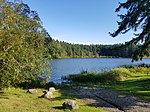Discovery Bay is an unincorporated community in Jefferson County, Washington. The community of Discovery Bay is an area near the intersection of U.S. Route 101 and State Route 20, at the foot of Discovery Bay – roughly midway between the larger communities of Port Townsend to the northeast and Sequim to the northwest. It is a mix of residential areas and commercial enterprises, including crabbing, oystering, clamming, timbering, security training and gravel extraction. A few restaurants and stores on US 101 near SR 20 primarily serve drivers and truckers along US 101.
Discovery Bay is the current name generally associated with the area. Its use for the community, as opposed to the bay itself, is relatively recent. The original communities in the area, primarily mill towns that waxed and waned along with the local timber industry, had different names:
Fairmont is a group of residences at the southeast corner of the bay, off SR 20 just northeast of US 101.
Discovery Junction is an abandoned railroad junction near Fairmont.
Uncas is an old mill community to the southwest of Fairmont, on the south side of US 101.
Fort Discovery is the original location of Capt. Vancouver's camp and the present headquarters of Security Services NW.
Maynard is an old mill community to the north of Uncas, along US 101 at the southwest corner of the bay. An abandoned sawmill just to the east of US 101 is a well-known remnant of this community. The mill has often been incorrectly identified as the 1858 Port Discovery Mill (see Port Discovery, below). It was, in fact, the Maynard Mill.These names often appear on maps and persist in local road names. The mill communities no longer have the population or visibility they enjoyed when the mills were operating, making these hamlets primarily matters of local historical interest. However, changing demographics and rising property values are leading to redevelopment of this area, and breathing new life into older names.
South Discovery now constitutes the entirety of the area around Discovery Bay, especially the area between Port Discovery and Port Townsend. The South Discovery voting precinct includes areas away from Discovery Bay, as well.
Several nearby place names are also prominent in Discovery Bay history:
Eaglemount is an area on the hills to the south of Discovery Bay, on the east of US 101 above high bluffs over Discovery Bay. (Eaglemount is sometimes depicted as a location on SR 20, but in fact it is reached by turning south on Eaglemount Road from SR20.)
Port Discovery is the location of George Vancouver's 1792 visit to Discovery Bay. Many sources incorrectly identify the current Discovery Bay community as the location of Port Discovery; however, Port Discovery was several miles to the north, at Mill Point on the west side of the bay. The site is along US 101, near today's Broders Road.There are several other communities located on or near the shores of Discovery Bay. Port Townsend occupies the northern end of the Quimper Peninsula, 5 miles (8 km) east of the northeast corner of the bay. The downtown area of Port Townsend, a famous seaport (once the major port of the region, before the rise of Seattle), is on the opposite side of the peninsula. Cape George is located on high bluffs at the northeast entrance of the bay; Beckett Point is a shoreline community a mile south. Another shoreline community, Adelma Beach is halfway down the bay. Gardiner is an unincorporated community several miles to the west along US 101, established by Herbert Gardner in the late 19th century. Diamond Point is located at the northwest mouth of the bay, opposite Protection Island, which once hosted a government quarantine station.



